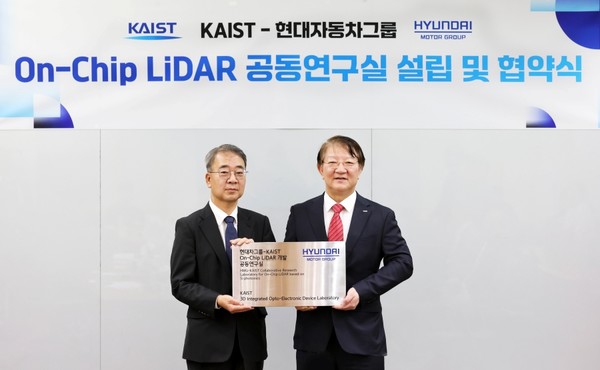KAIST, in partnership with Hyundai Motor Group, established the “Hyundai Motor Group-KAIST On-Chip LiDAR Development Joint Laboratory” on February 21. The new laboratory is composed of 30 researchers from the School of Electrical Engineering, including Professor Sanghyeon Kim, Professor Sangsik Kim, Professor Wanyeong Jung, and Professor Hamza Kurt, and a research team from Hyundai Motor Group's Advanced Technology Institute.

Light Detection And Ranging (LiDAR) sensors use lasers and analyze the reflected lights to measure real-time distances, essential to autonomous driving. The purpose of the lab is to reduce the size of the sensors while simultaneously increasing performance using silicon photonics and other core technologies that can help introduce next-generation signal detection methods. The lab will be operated for four years until 2028.
KAIST is currently leading LiDAR-based research, such as the development of silicon photonics-based small on-chip LiDAR devices and the production of high-speed, high-output driving integrated circuits for LiDAR operation, most of which are supervised by Professor Emeritus Hyo-Hoon Park of the School of Electrical Engineering.
The opening ceremony of the Joint Laboratory was held at the School of Electrical Engineering building (E3-2) on February 19. Notable figures in attendance were KAIST officials, including Senior Vice President for Research Sang Yup Lee, Dean of the College of Engineering Jaekyun Moon, and the Head of the School of Electrical Engineering Joonhyuk Kang. Hyundai Motor Group officials included Hyundai Motor Company Vice President Jong-Soo Lee, Hyundai NGV CEO Junghoon Oh, and the researchers participating in the joint research.
Professor Sanghyeon Kim, who is in charge of the joint research lab, stated, "The LiDAR sensor, which serves as the eyes of a car, is a core technology for future autonomous vehicle technology development and a technology that is essential for automobile companies to internalize." Professor Kim further emphasized the purpose of the collaboration, “As the joint research laboratory is established at a time when technology is very important, we will be able to lay a technological foundation to lead LiDAR-related technology.”

